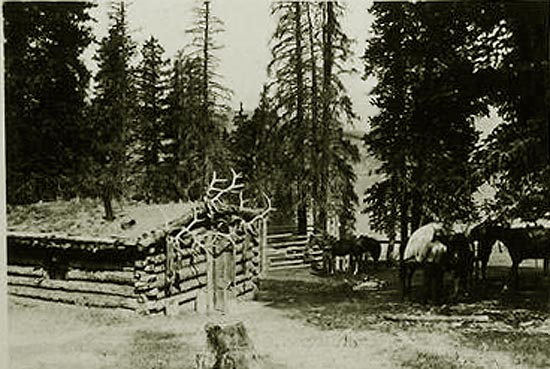
Cowcamp at Jack Creek.
The same scene would sometimes be used both in summer and winter.
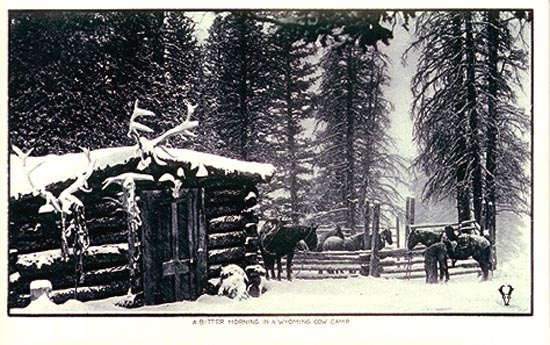
"A Bitter Morning in a Wyoming Cowcamp."
Frank Owens is checking the horse's leg.
The antelope symbol in the lower right-hand side of the photo was Belden's personal logo which appeared
on many of his photos. It also appears on the cowling of the airplane on the previous page. Antelopes constituted
a regular theme.
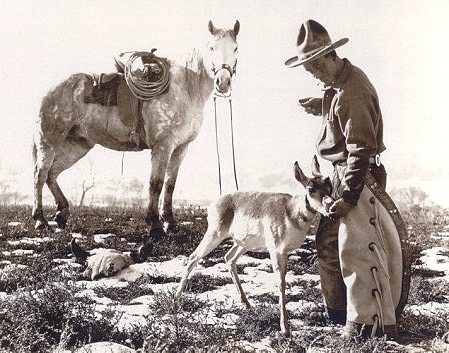
Jack Rhodes, Sr. with Fawn
Note the skull on the ground. Belden, as indicated in the photo, had an interest in antelope.
In July 1936, He would take newly born antelope and raise them, feeding them cow's milk. In this manner,
the antelope would be tame and would become used to humans. The antelope fawns could then be sold to zoos.
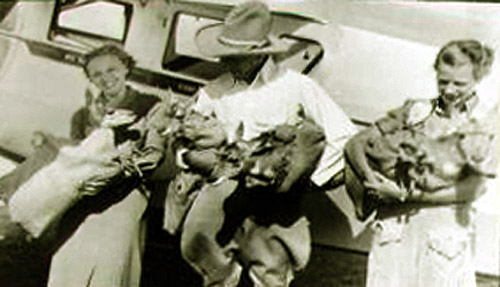
Antelope Fawns in Gunny Sacks for Shipment East, Bill Monday in center, 1936.
In July 1936,
Belden employed Bill Monday, a local aviator who owned a Ryan Monoplane, to fly Belden with 83 antelope fawns to various
zoos in the east, ending up in New York. There, two of the fawns were sent to Germany on the airship
Hindenburg. Belden received $100.00 apiece for each of the fawns.
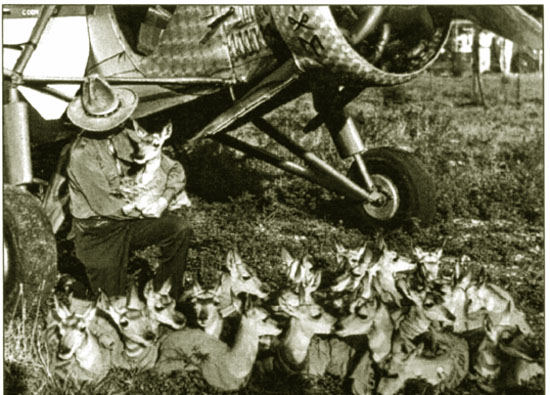
Antelope Fawns in Gunny Sacks for Shipment East, 1936. Bill Monday holding fawn.
The trip was a publicity bonanaza for Belden. The trip and Belden were written up by the
wire services. An article appeared in Time Magazine. The trip was written of in the New Nork
Daily Mirror, the Helena Independent, and the 1936 Aircraft Year Book
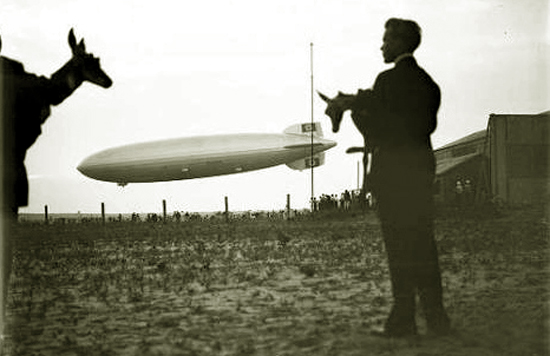
Two antelope fawns awaiting arrival of the Zeppelin Hindenberg at Lakehurst, New Jersy, for shipment to Berlin.
And just as he had earlier
become a writer on the wonders of automobile travel, Belden became an advocate for the use of airplanes in
ranching. In a Popular Mechanics article "Wings Over the West," September 1936, Belden contended,
The modern cowboy has swapped his horse for
an airplane. Up-to-date ranches are using
planes to round up wild horses, locate
stray calves, ride fences, bring buyers, rush emergency supplies, and when business is
done, to take the owner coyote hunting, or run races with the
fleet-footed antelope."
Of course, it provided great publicity for Belden and the Pitchfork. To refer to ranchmen who were interested in
aviation as "cowpilots" was palpable nonsense designed to promote an image similar to that projected by the later
"Sky King" radio program.
In 1941,Belden was quoted in the Journal of the Aeronautical Sciences as admitting that he didn't have a
private pilot's license because he was "too busy flying to learn to fly."
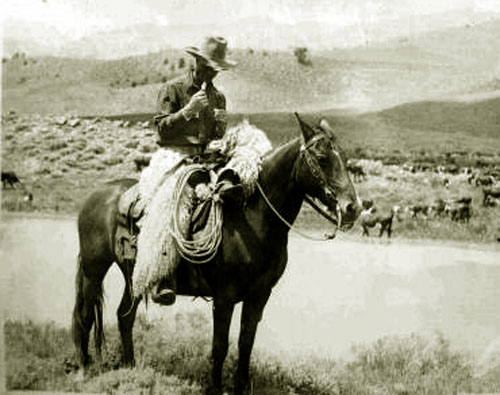
Cowboy on the Z Bar T
To gain proper prospective, the photos were frequently taken while Belden was on his favorite horse, "Pinky."
To steady the camera Belden used a monopod. The photos also contribute to the popular conception of a cowboy being similar
to the "Malborough Man." Indeed in recent years, some Malborough commercials were filmed on the
Pitchfork. Belden in the 1930's, however, was featured in advertisements for Camel Cigarettes.
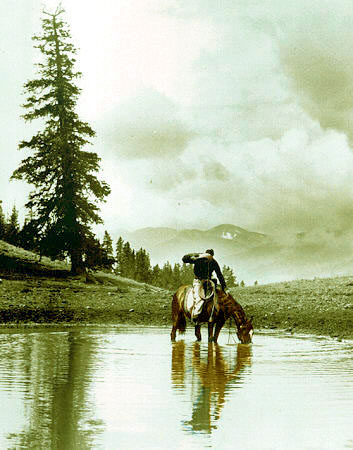
Elmer Bergquist at Jack Creek, Absaroka Mountains in the Background. Photo by
Charles J. Belden
The scene is southeast of Cody on a tributary of the Greybull River on the former Pallette Ranch. The Pallette became part of the
Pitchfork.
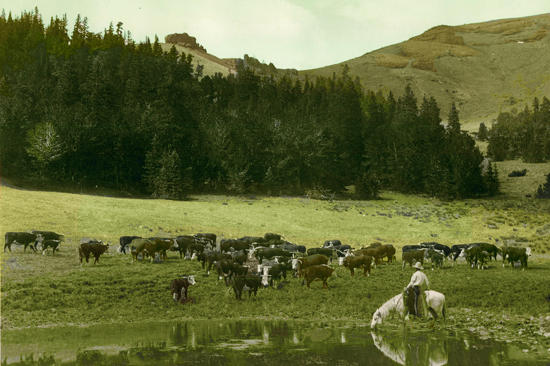
Cowboy watching herd on Pitchfork.
As Rick Ewig of the American Heritage Center noted in his "Give Them What They Want: The Selling of Wyoming's Image Between the Wars,"
Roberts, ed., Readings in Wyoming History (Laramie: Skyline West, 2000), Belden publicized himself.
Although, Belden never actually said it, he left the impression that the Pitchfork Ranch was his
and that he was the manager. He certainly dressed the part. Time Magazine referred to Belden as
"Clumping about Manhattan in his cowboy boots, ten-gallon hat." The Stetson Hat Company actually
named a Montana peak style hat for Belden. In actuality, the Ranch belonged to his wife and to his
brother-in-law. With the death of L. G. Phelps in 1922, operation of the ranch fell under the
guidance of Eugene Phelps and Belden. Phelps busied himself with an interest in electrification, irrigation and
minor inventions. Phelps held patents for a chain wrench, gate opener and a can opener.
Belden devoted himself to his photography and an interest in antelopes. Slowly the Pitchfork
fell into debt until it was finally put into receivership. The ranch was essentially rudderless.
Thus, ultimately it fell upon Belden's wife, Frances Phelps Belden (1889-1984), to rescue the spread.
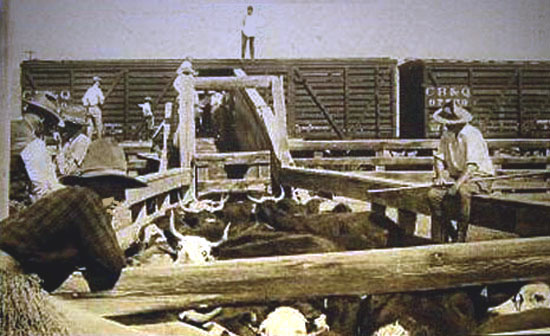
"A Cattle Pullman," Cody Railyards.
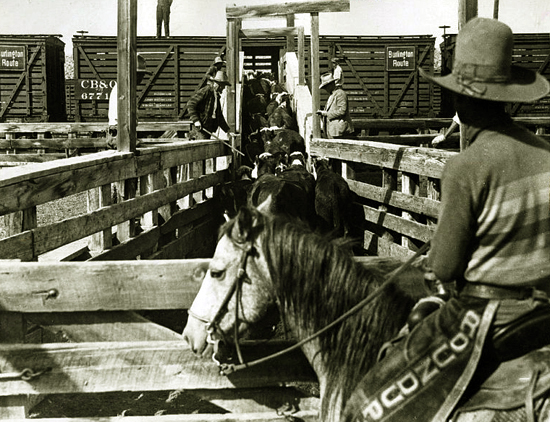
Loading at Cody Railyards.
Next Page, Belden Photos continued.
|














